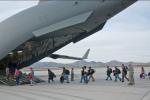
UCSD Ph.D. candidate (structural engineering) and von Liebig Fellow Arun Manohar demonstrates unique Enhanced Infrared Thermography algorithm to identify structural defects in composite wind turbine plates. | Image Courtesy of the San Diego Renewable Energy Fellowship.
How do we leverage the innovative minds of our university students to make our clean energy goals a reality? Bringing students and business expertise together early in the process is a crucial part of identifying promising technologies and making them successful in the marketplace.
For example, a simple, portable device that monitors defects in wind turbine blades will help make wind a more efficient and reliable alternative energy source. This is one of three new projects by teams of science and engineering graduate students at at the University of California, San Diego (UCSD) and San Diego State University (SDSU) that are receiving financial support and business mentorship through the Energy Department's Innovation Ecosystems Initiative.
UCSD and SDSU received a three-year, $1 million grant to create the Southern California Renewable Energy Technology Acceleration Program and amplify the already significant role that students play in facilitating the technology transfer process. In addition to the device to monitor wind turbine blade defects, the program includes projects to create a new high-efficient and mercury-free light bulb, as well as a new way to manufacture flexible, 3-dimensional organic solar cells at low cost.
Students play a crucial role in our energy innovation community, but they can encounter challenges in finding the support and expertise needed to turn their ideas and raw technologies into viable commercial products. Navigating the tumultuous roadblocks along the commercialization pipeline includes getting the technology market-ready, identifying a proof-of-market need, and putting together a viable business model and a business oriented management team — all of which are typically not in place at the research and discovery stages.
The Innovation Ecosystems Initiative is a $5.3 million grant given to five awardees across the nation in an effort to accelerate the movement of cutting-edge energy efficiency and renewable energy technologies from university laboratories to market. Through the Southern California Renewable Energy Technology Acceleration Program, three teams of science and engineering graduate students have been awarded a von Liebig Center Fellowship to pursue the commercialization of their research. They’ve also been paired with MBA students from SDSU and the Rady School of Management at UCSD.
Under the guidance of their faculty advisors and a von Liebig advisor, the science and engineering students will conduct proof-of-concept studies and prototype development. At the same time, MBA students for each team will conduct market research, collect customer feedback, and develop commercialization plans for the technologies.
Commercialization assistance at universities has primarily focused on the faculty inventor. However, as faculty members typically remain in academia, it has become apparent that involving students is critical to facilitating the technology transfer process.
Learn more about the following: Von Liebig Entrepreneurism Center, UC San Diego Rady School of Management, UC San Diego Jacobs School of Engineering.




